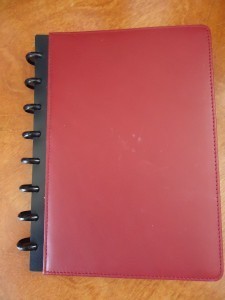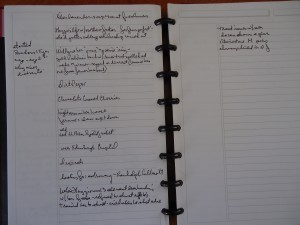Creating a Character Bible
Lea Wait, here,. A couple of weeks ago I wrote a blog about what I needed to do after I’d finished a book. One task I mentioned was updating my Character Bible. E.J. Runyon contacted me and asked that I explain what that was. So today I’m sharing how to create a writing tool I develop for each book I write. I find it important for stand-alone books — and indispensable for writing a series.
A character Bible.
No; I’m not referring to THE Bible.
I’m referring to a place — a notebook, an electronic file, a folder …. whatever you choose … that contains the important facts about the people and places in your book. Who wants a character to change eye colors between chapters two and twenty?
Everyone has to find their own “best way” to create a useful Bible. I’ve found a hand-written loose leaf notebook is easiest for me. I can update it by hand either while I’m writing or after … I can refer to it easily … and I can add (or sometimes subtract) pages when necessary. Some years ago I treated myself to a really nice leather “circa” notebook from Levenger, because it’s a comfortable size to take with me if I’m writing on the road, 6.5 x 8.5 inches, and I love the way it looks and feels. Since I use it all the time,I think of it as an investment. At the moment it contains information about the people and  places in both my Shadows Antique Print Mystery series and my Mainely Needlepoint Series.
places in both my Shadows Antique Print Mystery series and my Mainely Needlepoint Series.
OK — what’s in there? Maps of the major towns where the books are set — in these cases, Haven Harbor and Weymouth, Maine, and the campus where Maggie Summer teaches in New Jersey. If another town appears in a book I also draw maps … but usually I leave them in the folder of back-up information (research, ideas, outline, etc) I keep for each book.
Most of my Bible is made up of alphabetical listings of information about each character. A character who only appears in one book may have a short listing — how old he or she is, what they look like, and specific quirks they have, what their secret is, what they want, and what they’re willing to do to get it, and perhaps their relation to my series protagonist and to the specific plot line.
 In a mystery, if they’re either murdered or the murderer, that may be all I need — they’ll only appear in one, or maybe two, books.
In a mystery, if they’re either murdered or the murderer, that may be all I need — they’ll only appear in one, or maybe two, books.
For my major, repeating, characters, I include not only that basic information but other details.
For instance, my Bible tells me Maggie Summer (in the Shadows series) has never smoked, drinks Diet Pepsi, and loves chocolate covered cherries. She pays high taxes on her house in NJ. She drinks Dry Sack sherry out of Edinburgh Crystal. She likes to treat herself to baths with lavender-scented soap. Her father took her deer hunting when she was 13 but she refused to shoot, even though he’d taught her how to use a gun. She cried when he killed a doe. (He never took her hunting again.) And so forth
Angie Curtis, the protagonist of the Mainely Needlepint series? Her Gram calls her “Angel.” She has a birthmark on her shoulder that matches one her mother had. She has scars on her toes from walking on barnacle-covered rocks as a child. She drives a small red Honda, likes her coffee black, and is pretty flexible about her choice of beers – but prefers those made in Maine.
Gussie White reads late at night, so it’s OK to call her then. Aunt Nettie has a Thursday morning appointment every week at Cut ‘n’ Curl. Angie Curtis’ fashion-plate friend Clem Walker was fat as a teenager and now works for Channel 7 in Portland.
Not all those details appear in all my books — but they have been mentioned in at least one. The real purpose of the Bible is to ensure that my words don’t contradict themselves. I don’t want Maggie eating chocolate covered cherries in one book and being allergic to cherries in another. (If I don’t notice, one of my readers definitely will!)
The character Bible is also the place to include backstories, phobias, hair styles, fears and goals.
In addition to characters, I have pages for specific places — Harbor Haunts, a restaurant in Haven Harbor, has red Formica counters. Maggie Summer’s kitchen table is pine. What kind of trees are on the main street of town? What do characters’ houses look like? How far away are local hospitals, and how long does it take to drive there? All details that may be important in more than one book.
When do I put information in my Bible? I used to create or add information when I was planning my book. But although I do a general outline of each book before I start writing, I tend to change details as I write. So, for me, the time to create my Bible is when I’ve finished a strong draft, or when I send the manuscript to my editor.
Having the Bible helps avoid changing a character’s hair color, or height, or the name of his or her ex-spouse. It’s also a convenient place to check that I haven’t created two characters with the same first name (ouch! yes, that’s happened) or even two characters with similar last names. I try, in fact, to have all character names in one book start with different letters. That makes it easier for readers to keep them straight. (Me, too.)
Reading through the Bible not only makes sure I don’t make continuity mistakes; it also gives me ideas for future plots, and doesn’t let me forget minor characters who might have key roles to play in future books.
It is right next to my thesaurus and dictionary on my desk.
It is essential.
Lea Wait's Blog
- Lea Wait's profile
- 509 followers



